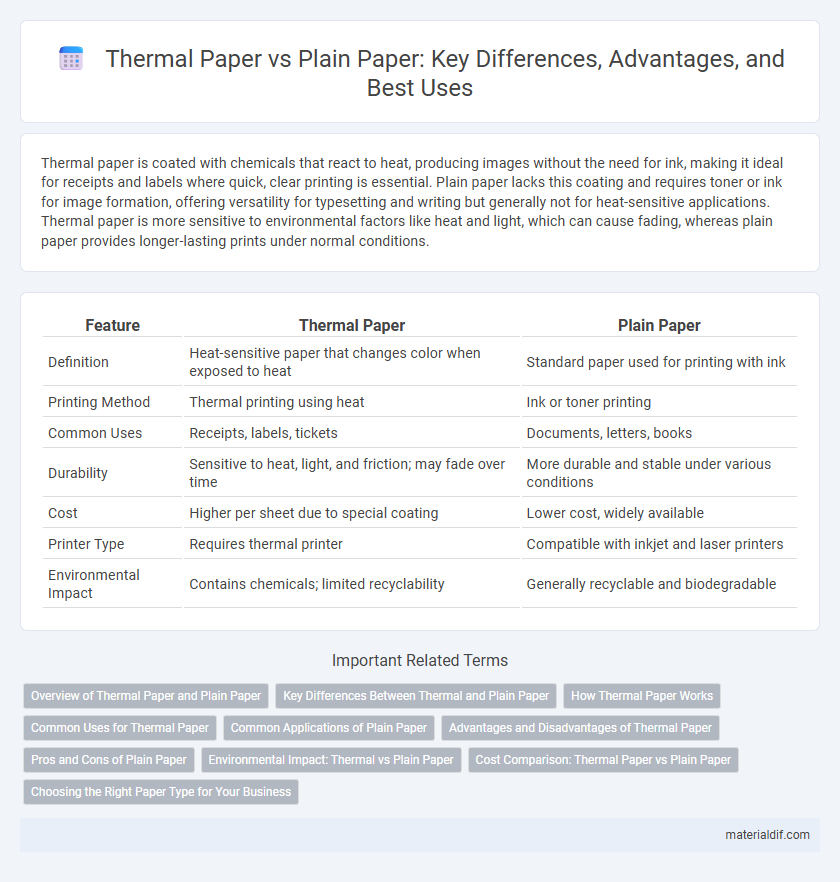Thermal paper is coated with chemicals that react to heat, producing images without the need for ink, making it ideal for receipts and labels where quick, clear printing is essential. Plain paper lacks this coating and requires toner or ink for image formation, offering versatility for typesetting and writing but generally not for heat-sensitive applications. Thermal paper is more sensitive to environmental factors like heat and light, which can cause fading, whereas plain paper provides longer-lasting prints under normal conditions.
Table of Comparison
| Feature | Thermal Paper | Plain Paper |
|---|---|---|
| Definition | Heat-sensitive paper that changes color when exposed to heat | Standard paper used for printing with ink |
| Printing Method | Thermal printing using heat | Ink or toner printing |
| Common Uses | Receipts, labels, tickets | Documents, letters, books |
| Durability | Sensitive to heat, light, and friction; may fade over time | More durable and stable under various conditions |
| Cost | Higher per sheet due to special coating | Lower cost, widely available |
| Printer Type | Requires thermal printer | Compatible with inkjet and laser printers |
| Environmental Impact | Contains chemicals; limited recyclability | Generally recyclable and biodegradable |
Overview of Thermal Paper and Plain Paper
Thermal paper is a specially coated paper designed to change color when exposed to heat, making it ideal for receipts, labels, and tickets due to its high-speed printing without ink. Plain paper, commonly used in everyday printing and writing, lacks this coating and requires ink or toner for image reproduction. The durability and environmental impact differ significantly, with thermal paper often containing chemicals like BPA, while plain paper is more versatile and recyclable.
Key Differences Between Thermal and Plain Paper
Thermal paper is coated with a chemical layer that darkens when exposed to heat, enabling fast, inkless printing ideal for receipts, tickets, and labels. Plain paper relies on traditional ink or toner printing technology, suitable for general document printing and copying, offering durability and compatibility with various printers. Unlike thermal paper, plain paper is less sensitive to heat and environmental conditions, making it more versatile for long-term document storage.
How Thermal Paper Works
Thermal paper contains a special heat-sensitive coating that changes color when exposed to heat from a thermal printhead, enabling fast and quiet printing without ink. This reactive layer typically consists of dye and developer crystals that melt and fuse upon heating, producing sharp and durable images. Unlike plain paper, which requires external ink or toner, thermal paper's direct chemical reaction simplifies printing mechanisms in devices like receipt printers and fax machines.
Common Uses for Thermal Paper
Thermal paper is commonly used in receipt printing, shipping labels, and tickets due to its ability to produce clear, quick-drying images without the need for ink or toner. Retail stores, banks, and transportation companies rely on thermal paper for efficient, cost-effective printing solutions that require minimal maintenance. Unlike plain paper, thermal paper's heat-sensitive coating ensures high-quality print durability ideal for time-sensitive documentation.
Common Applications of Plain Paper
Plain paper is widely used in everyday printing tasks such as documents, reports, and letters due to its compatibility with inkjet and laser printers. It is preferred for official paperwork, educational materials, and office correspondences where durability and archival quality are important. The versatility of plain paper makes it suitable for photocopying, note-taking, and general office use.
Advantages and Disadvantages of Thermal Paper
Thermal paper offers faster printing speeds and higher print quality due to its heat-sensitive coating, making it ideal for receipts and labels. However, it is more susceptible to fading over time and can be damaged by heat, light, and chemicals, which limits its archival use. In contrast, plain paper provides better durability for long-term storage but requires ink or toner, resulting in slower, more costly printing processes.
Pros and Cons of Plain Paper
Plain paper offers superior durability and compatibility with various printing technologies such as inkjet and laser printers, making it ideal for long-term document preservation. It lacks the heat-sensitive coating found in thermal paper, preventing smudging and discoloration over time, which enhances archival quality. However, plain paper generally requires ink or toner, which can increase printing costs and maintenance compared to thermal paper's inkless printing process.
Environmental Impact: Thermal vs Plain Paper
Thermal paper production often involves chemical coatings like BPA or BPS, which pose environmental and health risks during manufacturing and disposal. Plain paper is generally more eco-friendly, with lower chemical use and greater recyclability, reducing its ecological footprint. However, thermal paper's durability and resistance to fading can decrease waste over time by preserving printed information longer.
Cost Comparison: Thermal Paper vs Plain Paper
Thermal paper typically costs more per roll than plain paper due to its special heat-sensitive coating, which enables printing without ink. While plain paper prices are lower and widely available, additional expenses for ink and maintenance of ink-based printers increase overall costs. Businesses often find thermal paper more cost-efficient in high-volume or receipt printing scenarios because of lower printer upkeep and faster printing speeds.
Choosing the Right Paper Type for Your Business
Thermal paper offers fast, high-quality printing without ink, ideal for receipts and labels in retail or hospitality, while plain paper provides versatility for documents, copies, and everyday printing needs. Consider factors like print durability, cost efficiency, and printer compatibility to determine the optimal paper type for your business operations. Selecting the right paper enhances printing performance, reduces expenses, and supports business-specific applications effectively.
Thermal Paper vs Plain Paper Infographic

 materialdif.com
materialdif.com